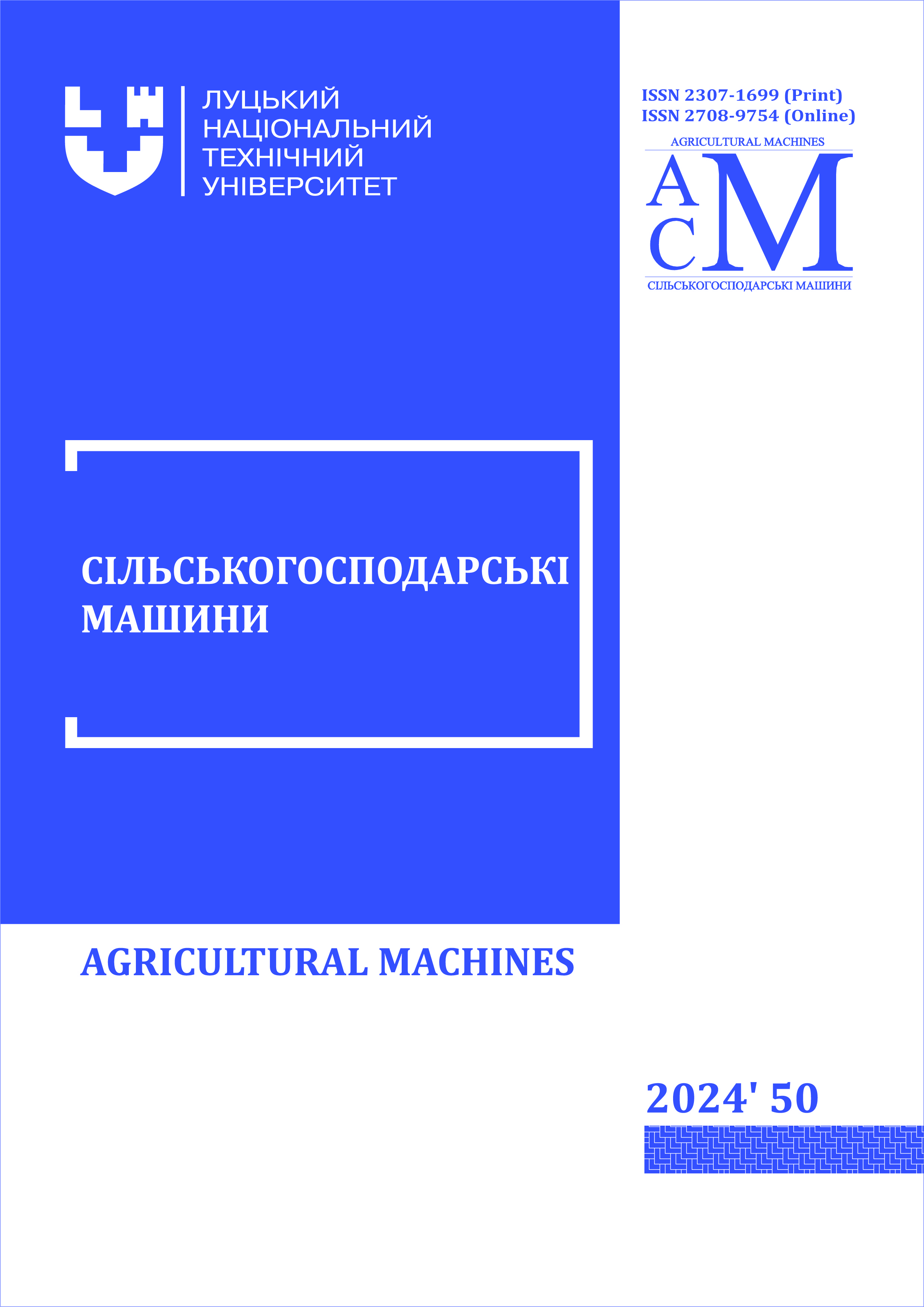ОБҐРУНТУВАННЯ ФОРМИ ПАЗУРЕПОДІБНОГО ПРУТКА ҐРУНТООБРОБНОГО АГРЕГАТУ ДЛЯ ПЕРЕДПОСІВНОГО ОБРОБІТКУ
Анотація
Для підготовлення ґрунту до посіву використовують ґрунтообробні фрези, що мають горизонтальну або вертикальну вісь обертання робочого органу. Горизонтальні ротаційні робочі органи дозволяють утворити три горизонтальні шари відносно орного горизонту з різним вмістом ґрунтових агрегатів. Для забезпечення одночасного подрібнення і сепарування ґрунту необхідно обґрунтувати форму та геометричні розміри робочого органу ґрунтообробного модуля для передпосівного обробітку ґрунту. Для визначення найбільш раціональної форми використано методику біонічного інжинірингу. Для цього розглянуто локомоцію та біомеханіку ґрунтової фауни, а саме процес взаємодії пазурів тварин з ґрунтом. Для визначення ступеня подрібнення ґрунту використано доопрацьовану математичну модель А. М. Панченка, що дозволяє провести аналіз роботи активних робочих органів, які одночасно виконують поступальний та обертальний рухи. Ураховуючи запропоновану модель подрібнення ґрунту проведено геометричний розрахунок форми прутка біонічного ґрунтообробного агрегату для передпосівного обробітку ґрунту на основі морфології пазурів тварин ґрунтової фауни та побудовано його тривимірну модель. З використанням методів зворотного інжинірингу (Reverse Engineering) проведено апроксимацію пазурів тварин. Розв’язуючи умову забезпечення найбільшого ступеня подрібнення ґрунту у програмному пакеті Wolfram Cloud з використанням функції FindMaximum, отримано рівняння, які описують зовнішню та внутрішню поверхні пазуреподібного прутка ґрунтообробного агрегату. Результати проведеного розрахунку форми пазуреподібного прутка біонічного ґрунтообробного агрегату будуть використані під час створення експериментального зразка агрегату та перевіряння якості подрібнення ґрунту.
Посилання
Babitsky, L. F., Sobolevsky, I. V., & Kuklin, V. A. (2020). Bionic modelling of the working bodies of machines for surface tillage. IOP Conf. Series: Earth and Environmental Science, 488, 012041. https://doi.org/10.1088/1755-1315/488/1/012041
Baeckens, S., Goeyers, C., & Van Damm, R. (2020). Convergent evolution of claw shape in a transcontinental lizard radiation. Integrative and Comparative Biology, 60(1), 10-23. https://doi.org/10.1093/icb/icz151
Kalinitchenko, V. P., Glinushkin, A. P., Sharshak, V. K., Ladan, E. P., Minkina, T. M., Sushkova, S. N., Mandzhieva, S. S., Batukaev, A. A., Chernenko, V. V., & Ilyina, L. P. (2021). Intra-soil milling for stable evolution and high productivity of kastanozem soil. Processes, 9, 1302. https://doi.org/10.3390/pr9081302
Li, L., Sun, W., Guo, C., Guo, H., Lili, L., & Yu, P. (2022). Mathematical model and nanoindentation properties of the claws of Cyrtotrachelus buqueti Guer (Coleoptera: Curculionidae). IET Nanobiotechnol, 16, 211-224. https://doi.org/10.1049/nbt2.12089
Matin, Md. A., Hossain, Md. I., Gathala, M. K., Timsina, J., & Krupnik, T. J. (2021). Optimal design and setting of rotary strip-tiller blades to intensify dry season cropping in Asian wet clay soil conditions. Soil and Tillage Research, 207, 104854. https://doi.org/10.1016/j.still.2020.104854
Pingyuan, X., Zhou, Y., Zhiquan, S., Qianqian, Z., Yangqing, H., & Zhuowei, Z. (2018). Simulation analysis and experiment for three-axis working resistances of rotary blade based on discrete element method. Transactions of the Chinese Society of Agricultural Engineering (Transactions of the CSAE), 34(18), 113-121. https://doi.org/10.11975/j.issn.1002-6819.2018.18.014
Toscano, P., Brambilla, M., Cutini, M., & Bisaglia, C. (2022). The stony soils reclamation systems in agricultural lands: A review. Agricultural Sciences, 13, 500-519. https://doi.org/10.4236/as.2022.134034
Tsang, L. R., Wilson, L. A. B., Ledogar, J., Wroe, S., Attard, M., & Sansalone, G. (2019). Raptor talon shape and biomechanical performance are controlled by relative prey size but not by allometry. Scientific Reports, 9, 7076. https://doi.org/10.1038/s41598-019-43654-0
Tu, C., Li, J., Wang, X., Shen, C., & Li, J. (2021). Bionic technology and deep learning in agricultural engineering: current status and future prospects. American Journal of Biochemistry and Biotechnology, 17(2), 217-231. https://doi.org/10.3844/ajbbsp.2021.217.231
Wang, L., Xing, J., He, X., Li, X., Guo, W., Wang, X., & Hou, S. (2023). Study on the mechanism of motion interaction between soil and a bionic hole-forming device. Agriculture, 13, 1421. https://doi.org/10.3390/agriculture13071421
Xu, G., Xie, Y., Liang, L., Ding, Q., Xie, H., & Wang, J. (2022). Straw-soil-rotary blade interaction: interactive effects of multiple operation parameters on the straw movement. Agronomy, 12, 847. https://doi.org/10.3390/agronomy12040847
Yang, Y., Li, M., Tong, J., & Ma, Y. (2018). Study on the Interaction between soil and the five-claw combination of a mole using the discrete element method. Applied Bionics and Biomechanics, 7854052. https://doi.org/10.1155/2018/7854052
Yang, Y., Tong, J., Huang, Y., Li, J. & Jiang, X. (2021). Impact of the multi-claw combination on the soil-cutting performance of Scaptochirus moschatus (Mammalia, Soricomorpha, Talpidae). Rendiconti Lincei. Scienze Fisiche e Naturali, 32, 869-879. https://doi.org/10.1007/s12210-021-01032-x
Yongxiang, L. (2004). Significance and progress of bionics. Journal of Bionic Engineering, 1(1), 1-3. https://doi.org/10.1007/BF03399448
Zhang, Z., Song, Y., Ren, L., & Zhang, H. (2020). Research on simulation analysis of soil cutting process by ditcher. Journal of Physics: Conference Series, 1550, 042003. https://doi.org/10.1088/1742-6596/1550/4/042003
Zhang, J., Xia, M., Chen,W., Yuan, D., Wu, C., & Zhu, J. (2023a). Simulation analysis and experiments for blade-soil-straw interaction under deep ploughing based on the discrete element method. Agriculture, 13, 136. https://doi.org/10.3390/agriculture13010136
Zhang, X., Zhang, L., Hu, X., Wang, H., & Shi, X. (2023b). Calibrating contact parameters of typical rotary tillage components cutting soil based on different simulation methods. Scientific Reports, 13, 5757. https://doi.org/10.1038/s41598-023-32881-1
Zhang, Z., Zhang, Y., Zhang, J., & Zhu, Y. (2019). Structure, mechanics and material properties of claw cuticle from mole cricket Gryllotalpaorientalis. PLOS ONE, 14(9), e0222116. https://doi.org/10.1371/journal.pone.0222116
Кочеткова, І. Б., & Сушко, Л. Ф. (2013). Вища математика в формулах та таблицях (Higher Mathematics in Formulas and Tables). Дніпропетровськ: НМетАУ.
Панченко, А. Н. (1999). Теория измельчения почв почвообрабатывающими орудиями (Theory of Soil Grinding With Tillage Tools). Днепропетровск: ДГАУ.











